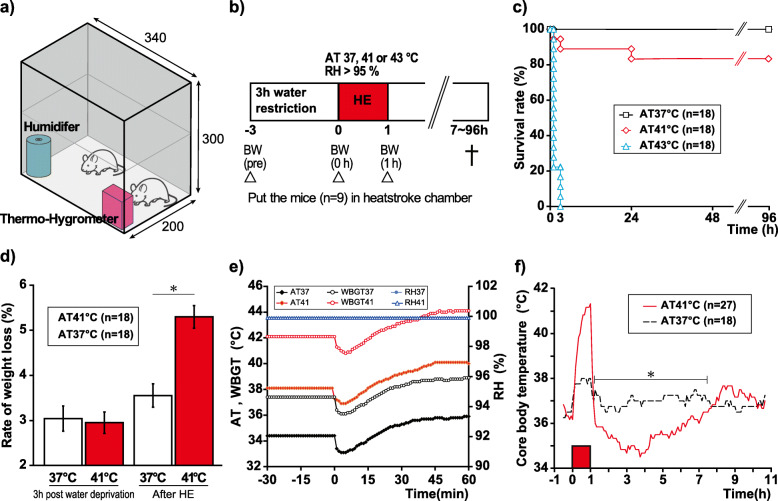Fig. 1.
Experimental protocols and examination of conditions for our mice heat stroke model. a Heatstroke chamber: The heatstroke chamber was made using acrylic resin in a construction similar to a greenhouse. An ultrasonic humidifier was placed in the corner, and a thermo-hygrometer was used to monitor the environmental conditions. b Protocol for heatstroke: The mice (n = 9) were exposed to heat (ambient temperature 37 °C, 41 °C, or 43 °C) and relative humidity (> 99%) for 1 h and then returned to the chamber set to room temperature. They were sacrificed 7–96 h after heat exposure. c Survival rate (%) under three different ambient temperature (37 °C, 41 °C, or 43 °C) conditions observed during 96 h: All mice died within 3 h of exposure to the ambient temperature of 43 °C. The survival rate at the ambient temperature of 41 °C was 15/18 (83.3%). d Rate of body weight loss (%) at the ambient temperature of 37 °C and 41 °C: 3 h of water restriction induced approximately a 3% body weight loss at the ambient temperature of 37 °C and 41 °C. Body weight significantly decreased after 1 h of exposure to the ambient temperature of 41 °C, compared with that observed at the ambient temperature of 37 °C (t test, *p < 0.05). e WetBulb globe temperature (WBGT) and relative humidity under ambient temperature between 37 and 41 °C: WBGT always shows higher values than those of ambient temperature due to high humidity. RH was stabilized by more than 99.0% before and during the experiments. f Changes to core body temperature at ambient temperature of 37 °C and 41 °C: The core body temperature of the mice exposed to the ambient temperature of 41 °C increased markedly; subsequently, it decreased to 34.0 ± 0.18 °C (195 min after heat exposure). Then, the core body temperature gradually returned to physiological levels that showed biphasic thermal dysregulation response. There were significant differences in the core body temperatures measured during 1.0–7.4 h between the groups (t test, *p < 0.05).

